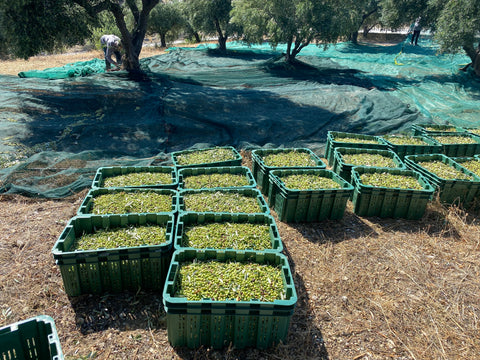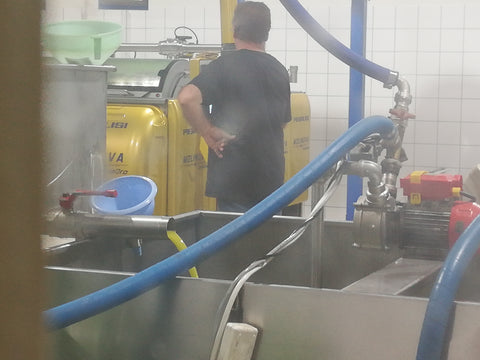Cretan Olive Harvest
Olive Harvest Fever!
My first experience of harvesting olives in Crete was a revelation. Crete transforms almost overnight from a busy tourist destination into a hive of farming activity - everyone seems to have olive fever! The sole topic of conversation is olive-related: how the trees are looking; whether there has been 'dakos' (olive fly) infestation; how big the crop is; which factory you are going to use; is your team ready; what is the olive oil yield, the acidity.
To get you in the mood, here is a video with some highlights of our October 2022 harvest
and the November harvest (riper olives)
Harvesting is a family affair. Most families in Crete own their own olive fields, and will generally harvest at least enough olives to provide the family with enough oil for the following year. Children are brought to the fields with their parents throughout the year to care for the olive trees. All ages and sexes are involved (and sometimes animals too!) and family members do not get paid!
At harvest time, people of all kinds, shapes and sizes come out of the woodwork and are busying around in a feverish state: huge Cretan farmers with long hair and beards driving around in pickup trucks heavily laden with sacks or crates of olives; ancient couples chug along the main roads on similarly ancient tractors.

At harvest time, people of all kinds, shapes and sizes come out of the woodwork and are busying around in a feverish state: huge Cretan farmers with long hair and beards driving around in pickup trucks heavily laden with sacks or crates of olives; ancient couples chug along the main roads on similarly ancient tractors.
The Cretan harvest season begins in October and lasts until end of January. The earlier the olives are picked, the greater the proportion of 'green' or 'unripe' olives - as opposed to dark purple or black 'ripe' olives. October harvest usually results in an oil made from olives which are predominantly green; harvest in November produces a mix of olives, both green, turning black and black; whilst later harvests result in 100% ripe olives.
The timing of harvest is important because it affects the taste and quality of the olive oil - and also the amount of oil produced. We pick our olives in October and November. Read more about different types of olive oil here.
Before harvest begins, you must check all your equipment is ready: the ground nets, the collecting crates (or sacks), the olive separator or rakes; the harvesting sticks; the generator; your truck for taking the olives to the mill - and of course, making sure that your chosen olive factory is open and ready! And then you have to have your team of pickers: depending on the size of the fields and on how quickly you want the job done, you may have anything upwards of 4 people.
The Typical Harvesting Day

Harvesting olives in Crete is very hard work. Crete is very mountainous, and many olive fields are located on hill slopes with difficult vehicular access: good leg work, strong backs and pure brawn is required!
The day starts at 8am, and continues with perhaps one or two coffee breaks through to lunch at around 2pm. Generally the 'afentiko' - or head man (or woman) organises the pick: where to start, how to move through the field, where the nets should be laid, who should pick which trees; and which can be picked by hand, etc. Very often the older folk will be given the role of moving the nets, whilst the strapping young men or women do the olive picking.

The olives are flicked onto the nets using the gently rotating harvesting sticks, or collected by hand into a bag or net. The olives can be fired off at great speed, and eye (or other facial) injuries are common, so it is advisable to wear goggles at all times.

The leaves which inevitably fall into the nets then have to be separated out either by a mechanical sieve, or a large soft rake. The heavy sacks of olives and leaves gathered from the nets are then loaded by the young men into the siever in order to separate the olives from the leaves.


The olives are then loaded into crates (preferably) or sacks. Crates are preferable because the olives are more loosely packed, and air can circulate around them, thus reducing the chances of damage and oxidation. 

At the Olive Factory
After picking has finished for the day, the next stage begins! The Olive Factory! The crates of olives are loaded into the back of a pick up truck and driven to the olive mill. Depending on how far away this is, and how busy it is, you can plan to be there until late at night. The mills typically work 24 hours a day during harvest.

On arrival at the olive factory, the olives are loaded directly into the olive funnel or transferred into giant bins (each one holds around 250Kg of olives) to await their turn, before being transferred into the receiving funnel. From the receiving funnel, the leaves are sucked up into a chimney and collected separately for shepherds to collect as fodder for their herds. The olives being heavier fall to the lower part of the chimney and enter the washing tray where they are washed in cold water.


After washing the olives are milled and then the oil is separated from the water and the solid waste (husk and stone).

Traditionally, milling was done with a millstone or hammer stone, and oil extraction achieved by hydraulic press. A more modern method is continuous cycle centrifugation. When the olives are of sufficiently good quality, the first pressing produces extra virgin olive oil.
These final images shows our oil (Filoxenia is one of our Greek oil producing companies for our farm) being poured into our 50 Litre containers from which the oil will be sedimented and filtered prior to bottling!

......AND HERE IS THE FINAL PRODUCT!



Leave a comment